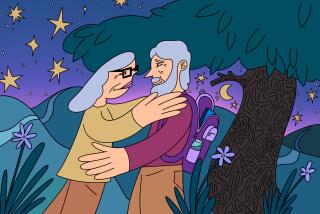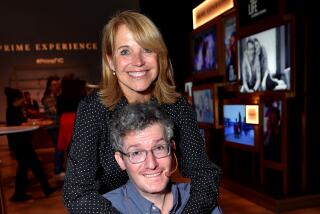Disease Underscores Couple’s Vows of Sickness, Health
- Share via
NEWTON, Mass. — It began with daylong hikes in the hills, evenings watching rented videos, nights kissing on her balcony as the moon hung in the thick, humid sky. After two months, they were using the word “love.”
“He’s the one,” Wendy Stacy told her sister. It was fall 1998. Stephen Heywood, a 29-year-old carpenter, had just moved back to his hometown and was looking for a row house to renovate. Wendy, 33, was working and taking classes.
But there was that problem with Stephen’s right hand that wouldn’t go away. When he put the key into the door, he couldn’t turn it; when his fingernails got long, he hadn’t the strength to clip them.
Then: a doctor’s appointment. Tests. More tests. In December came the news: Stephen had ALS--Lou Gehrig’s disease. A condition that methodically cripples the nervous system, paralyzes its victims, then kills them.
Stephen had two, maybe five years left. And this is where the couple’s story really begins.
There were no anguished goodbyes for Stephen Heywood and Wendy Stacy. Instead they stayed together. They shared a first Christmas. In February they married. Come September, they are expecting a child.
An ALS diagnosis not only sets a cruel deadline, but guarantees remaining days filled with pain. How could they commit to such an uncertain future, much less rear a child in it?
For them, it was hardly a choice. Instead it was an unavoidable detour to a place where vacations matter more than careers, half-birthdays are celebrated and minor holidays are marked with diamonds. Where the only thing that feels normal is to be together.
Today Stephen and Wendy are marking newlywed rituals: first apartment, first car, getting to know in-laws. But each activity carries special heft, for each is accompanied by the strange edge of the ticking clock.
How long will Stephen be able to drive? How long will he be able to climb the four flights to their apartment? Will he be around for a second child?
It is in this particular soil that their romance has taken root.
*
“There’s no reason 30-year-olds should be talking about wills and disabilities and remarriages,” Stephen Heywood says, nervously adjusting his baseball cap. It’s a gorgeous spring day, and he is reflecting on how the diagnosis of amyotrophic lateral sclerosis has affected his relationship and his life.
He’d have been outside on a day like this, wrapping up a house renovation. Now that sort of high-coordination work is impossible; his fingers curl rigidly, and his misbehaving legs force his lanky, 6-foot-3 frame to wobble and struggle with curbs. Sometimes he just topples.
Sure, Stephen could oversee projects. But with the limited time he has left, he says, working long hours seems dumb. He wants to spend time with family and friends and strive for a normal relationship. “Normal” is a word Stephen uses a lot, but the concept seems cruelly elusive.
“It’s frustrating,” he says, “because we had a pretty normal courtship and falling in love.” As he speaks, an e-mail from Wendy pops up: “Hug kiss,” she writes.
When the preliminary diagnosis came in December 1998, they had not only sexual sparks to spare but also that intangible connection--that “click” that made being together effortless.
Back then, their conversations were about how to mix the perfect gin and tonic or how much better vampire movies were than ponderous art-house films. Stephen would mention doctors’ appointments and raise the possibility that something was wrong, and Wendy would dismiss it.
“I’d say, ‘Pshaw, look at you, you’re a healthy man. Look how big you are,’ ” she says.
But the diagnosis did come, just before Christmas. Stephen had gone in for some brief tests. Instead, for five hours, a neurologist inserted needles into his arms, his legs, even his tongue, trying to read the muscles’ electrical activity.
By the end of the day, everything seemed to point to ALS.
“He came back from the doctor’s and he said, ‘If I’m dying, will you have my baby?’ And I said, ‘Sure, sure, but you’re not dying,’ ” she says. “It was just so obvious without even being said that wherever we were going, we were going together.”
Wendy didn’t go home to Missouri for Christmas that year. During the next month, between her job as a Harvard professors’ assistant and working toward her master’s in biology, she began quietly researching ALS on the Internet.
“I’d say, ‘He has it. He has ALS.’ And then I’d say, ‘No, I’m just being dramatic,’ and then I’d feel better,” she says. “I’d just look at him and think, he walks fine, he gets around great. So he doesn’t use his right hand that well--he’ll be all right; we’ll fix him.”
Wendy waited by the phone the January day Stephen went for a formal diagnosis. By nightfall, he hadn’t called. She knew.
“I cried and cried and cried,” she says.
Things began to change fast around Wendy and Stephen. Stephen’s older brother moved home from California and launched an ALS therapy development organization in the basement. Friends and relatives joined in. His home became ALS central, filled day and night with charts and ringing phones.
Stephen began to retreat, sleeping at Wendy’s, looking for some space without ALS.
“She was saying almost immediately, ‘I want to get married,’ and I was thinking, ‘Are you nuts? Are you being rational?’ ” says Kate Collignon, Wendy’s roommate at the time. “But she seemed to know exactly what she needed, and things didn’t change.”
Wendy and Stephen say their decision to marry and have a child made sense. They shared the same values and goals, after all, and they knew they probably didn’t have much time.
*
No matter how hard Stephen and Wendy try to be a normal couple, ALS continues to wash itself like a perpetual tide over every corner of their relationship.
It has forced them to map out everything, from how many children they likely have time for to when the wedding would be. “We want to make sure that he can walk down the aisle,” Wendy said before the nuptials.
Stephen has stopped building and works with family and friends at the ALS Therapy Development Foundation, founded by his brother, Jamie, to experiment with treatments for a disease that is barely understood.
Wendy is rethinking her plan to get a master’s degree and is considering returning to publishing, where she can make money--no small matter, given the years ahead that she may well spend alone.
Six months after Stephen and Wendy moved into Boston’s elegant Back Bay neighborhood, in an apartment overlooking the Charles River, Stephen’s legs had deteriorated so far that he couldn’t climb stairs. They are looking for a more accessible home near his parents in Newton.
Without ALS, they’d have the privacy newlyweds are usually allowed. Now, she says, “everyone wants to spend time with Stephen.” Without ALS, they’d be having more fun. Less chaos. More money. Less stress.
And yet the sickness has forced Wendy and Stephen to take time together they probably wouldn’t otherwise. They have gone on long vacations and frequent weekend trips, even though Stephen is losing stamina by the week.
Stephen and Wendy’s wedding was another attempt at normalcy. Pachelbel’s Canon played. People cried when the bride appeared, clapped when they kissed, ate cake together.
But there was an extraordinary air about the church that February night. Friends bit lips to keep from crying. Relatives coughed to mask sobs as Stephen, beaming, wobbled down the aisle.
And the Rev. James McAlpine lent words to what everyone realized: This young couple knows that real love “goes beyond romantic love--a love that accepts suffering and loss as well as joy and new life.”
*
AP writer Michelle Boorstein and Stephen Heywood have been friends since they attended Newton North High School in Massachusetts in the 1980s.


